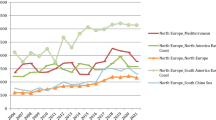Abstract
The virtual disappearance of liner shipping conferences from US markets and their elimination in European trades create a significant risk that in place of these collusive price-setting groups, the industry could become increasingly consolidated. The absence of the conference pricing cushion could end up giving an advantage to large, cost-efficient carriers who will drive smaller players from the market. During this competitive process, shippers could see lower freight rates and better service but as the industry consolidates towards oligopoly, there is the risk that shippers will be faced with fewer alternatives to move their goods, lower service quality and significantly higher prices. The impact on merchandise trade could be substantial. This paper is intended to reveal basic structural characteristics of the liner shipping industry that could point to more accurate predictions of future consolidation activity. In particular, a series of mergers and acquisitions in the industry will be examined against the backdrop of industry structure and regulatory constraints. Ultimately, a Poisson model is formulated and estimated to extract and quantify the structural factors that increase the likelihood of horizontal merger and acquisition activity.

Similar content being viewed by others
Notes
While mergers waves are empirically supported there is no evidence that they occur with any specific periodicity. See Golbe and White (1993) and Barkoulas et al (2001).
Gort (1969) provides the comprehensive neoclassical view on merger activity. More up-to-date research on the topic is found in Andrade and Stafford (2004), Andrade et al (2001), Mitchell and Mulherin (1996) and Jensen (1993).
Goriatchev (2006, p. 6).
This was particularly true in the airline industry. See Gregor et al (2001).
Schoenberg and Richard (1999) find that while ‘… exposure to deregulation is in fact the most important single discriminator between industries with high and low acquisition activity, industry concentration and industry growth rate are also supported as determinants of the takeover rate within an industry’.
There were no instances of negative demand growth greater than 1 standard deviation for the length of the sample period.
The LR test measures how well the model predicts the dependent variable relative to just a constant term.
See for example, Maloney and Robert (1988) and literature cited in Note 2.
India is the latest country to have abolished liner shipping conferences from its markets.
See Lam Jasmine et al (2007) for a comprehensive view of structure conduct and performance in liner shipping.
There is no conclusive evidence that concentration in liner shipping positively and significantly influences price. See Haralambides (2004) for a discussion.
References
Andrade, G. and Stafford, E. (2004) Investigating the economic role of mergers. Journal of Corporate Finance 10: 1–36.
Andrade, G., Mitchell, M. and Stafford, E. (2001) New evidence and perspectives on mergers. The Journal of Economic Perspectives 15 (2): 103–120.
Barkoulas, J.T., Baum, C.F. and Chakraborty, A. (2001) Waves and persistence in merger and acquisition activity. Economic Letters 70 (2): 237–243.
Bernile, G., Lyandres, E. and Zhdanov, A. (2006) A theory of strategic mergers. EFA, Zurich Meetings Paper.
Cameron, A.C. and Trivedi, P.K. (1990) Regression-based tests for overdispersion in the poisson model. Journal of Econometrics 46: 347–364.
Federal Maritime Commission. (2001) The Impact of the Ocean Shipping Reform Act of 1998. Federal Maritime Commission.
Golbe, D. and White, L. (1993) Catch a wave: The time series behavior of mergers. Review of Economics and Statistics 75 (3): 493–499.
Gort, M. (1969) An economic disturbance theory of mergers. Quarterly Journal of Economics 83: 624–642.
Gorton, G., Kahl, M. and Rosen, R. (2000) Eat or be eaten: A theory of mergers and merger waves. Wharton School, Working Paper.
Goriatchev, S. (2006) Eat or be eaten: The empirical evidence. University of Zurich, Working Paper.
Haralambides, H.E. (2004) Determinants of Price and Price Stability in Liner Shipping, Workshop on ‘The Industrial Organization of Shipping and Ports’, 5–6 March, National University of Singapore, Singapore.
Jensen, M. (1993) The modern industrial revolution, exit, and control systems. Journal of Finance 48: 831–880.
Lam, J.S.L., Yap, W.Y and Cullinane, K. (2007) Structure, conduct and performance on the major liner shipping routes. Maritime Policy and Management 34 (4): 359–381.
Lambrecht, B.M. (2004) The timing and terms of mergers motivated by economies of scale. Journal of Financial Economics 72 (1): 41–62.
Maloney, M.T. and Robert, E.M. (1988) Excess capacity, cyclical production, and merger motives: Some evidence from the capital markets. Journal of Law and Economics 31 (2): 321–350.
Mitchell, M.L. and Mulherin, J.H. (1996) The impact of industry shocks on takeover and restructuring activity. Journal of Financial Economics 41: 193–229.
PIERS (Port Import Export Reporting Service). (1995–2005) On Board Review, Various issues.
Schoenberg, R. and Richard, R. (1999) What determines acquisition activity within an industry? European Management Journal 17 (1): 93–98.
Author information
Authors and Affiliations
Rights and permissions
About this article
Cite this article
Fusillo, M. Structural Factors Underlying Mergers and Acquisitions in Liner Shipping. Marit Econ Logist 11, 209–226 (2009). https://doi.org/10.1057/mel.2009.3
Published:
Issue Date:
DOI: https://doi.org/10.1057/mel.2009.3




